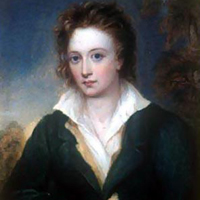Ozymandias by Percy Bysshe Shelley: Literary Appreciation
This little piece of poetry is a piece of narrative, narrated by a traveller, who appears once in the poem. The first person speaker (I) recollects his meeting with the traveller, who had told him all the details about the statue of Ozymandias and also about its sculptor.

P. B. Shelley (1792-1822)
The first person speaker reports that the traveller was from an 'antique' land. The word 'antique' is itself 'ancient.' The person may have come from Athens, Sparta, Rome or other parts of the world which are still well known for antique culture. It is also possible that the speaker prepares us to believe the content of the poem. Besides, the poet takes us to the dramatic situation of the poem. The traveller comments on the character of Ozymandias, which is the basic interest of the poem. This man introduces us to Ozymandias, of making 'bridge' between the 'antique' past (historical character of Ozyniandias) and the present (presentation of the King in the form of a statue by the sculptor). The whole powerful effect of the poem depends on the clear, bold presentation of the situation.
The obvious narrated details of the poem - "… traveler… legs of stone… desert… shattered visage… sneer… pedestal… .‘My name is Ozymandieas…” lone and level sands…” form a picture of a desert landscape, and in it the remains of a great statue, which once must have depicted in large proportions a great king or ruler. Now only the legs are left standing, and most of the other parts of the body have disappeared, or are unrecognizable. One detail that the traveler, particularly observed, however, were the fragments of the face. Although "shattered" the face retained a very lifelike expression, and it was possible to recognize the 'frown', the 'wrinkled lip', and 'sneer of cold command', which suggest to us that the original statue represented a man who was bad-tempered, heartless, cruel. The sculptor might have engraved these qualities in the statue to justify his skills or her might have suffered at the hand of the cruel king. He might have read well all those passions of the king, and therefore, he survived them stamping on those lifeless things, i.e. the fragments of the statue that were noticed by the traveller. The skillful hand and well-feeling heart of the artist made fun of those passions of the king. We can feel the satire made on the character of the king, when we read the words on the pedestal — "My name is Ozymandias, King of Kings.” It is merely an ego, a pride, and also a sense of defiance of all other rulers who have hoped to be compared with him. Presumably they can never hope (in Ozymandias' opinion) to equal the magnificence and power symbolized by his mighty statue, which is possibly just one sample of his "works".
The artist is technically very skillful in presentation of irony. The king of kings might have been very powerful and had all the qualities mentioned in the poem in his lifetime, but after death "nothing beside remains." Round the decay of that colossal wreck (i.e, fragmented particles or the statue), the lone (quiet, timely) and Level sands stretch far away, boundless and bare. It is interesting to observe that nowhere does the poet dictate an attitude to us, but yet unmistakably, we feel that the poem is satirical; that Ozymandias is being 'condemned, and perhaps also mocked, for his foolish, presumption in supposing that his power was permanent. This is the very theme of the poem. The poet intends to tell us this basic thing.
Poetic techniques that have been applied here are remarkably interesting. "Antique" status of the king defines the character of Ozymandias. The words 'frown', 'wrinkled lip', 'slice'', 'cold command' and sharp, uncompromising words that define the character. The adjective 'shattered', with its effect of violent explosion, suggests the finality with which not only the king's 'visage', but also his whole empire has been scattered into fragments. There is a plain, prosaic statement, e.g., 'And on the pedestal these words appear...', and then suddenly a great trumpet-like burst of sound, e.g. 'My name is Ozymandias, King of Kings'. He challenges - "Look on my works, ye Mighty, and despair', but ironically now 'nothing beside remains'.
The first four and the last four lines have a regular rhyming pattern. Words have been compacted into the rhythmic pattern, and the sounds of alliteration and assonance can be felt. For example,
Who said: "Two vast and trunkless legs…..
Also, -- 'King of Kings" (alliteration)
I met a traveller from an antique land (assonance)
Metaphors 'read' those passions, 'stamped' on those lifeless things, 'hand' and 'heart' have been used, but yet the simple, plain statements mark the poem highly. There are symbolic meanings, too; For example, Ozymandias, and his undignified end reminds us of the inevitable fall of all tyrants who ever existed or will exist.
Cite this Page!
Sharma, K.N. "Ozymandias by Percy Bysshe Shelley: Literary Appreciation." BachelorandMaster, 3 July 2014, bachelorandmaster.com/britishandamericanpoetry/ozymandias-literary-appreciation.html.
